104 11.4 Structure of Bone
Created by CK-12 Foundation/Adapted by Christine Miller
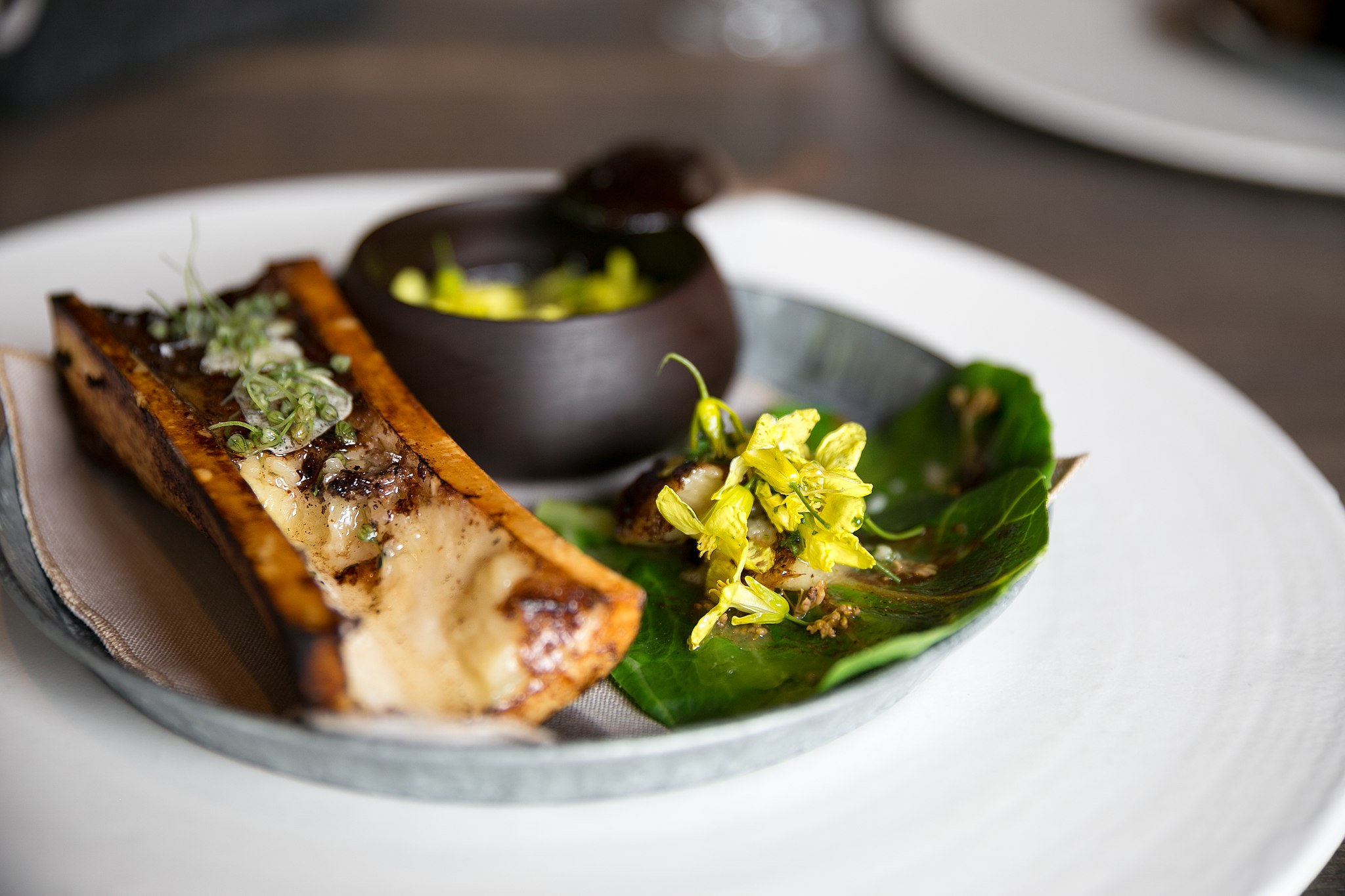
Roasted Bone Marrow
Do you recognize the food item in the top left of Figure 11.4.1? It’s roasted bone marrow, still inside the bones, and it is considered a delicacy in some cuisines. Marrow is a type of tissue found inside many animal bones, including our own. It’s a soft tissue that, in adults, may be mostly fat. You’ll learn more about bone marrow and other tissues that make up bones when you read this section.
What Are Bones?
Bones are organs that consist primarily of bone tissue, also called osseous tissue. Bone tissue is a type of connective tissue consisting mainly of a collagen matrix that is mineralized with calcium and phosphorus crystals. The combination of flexible collagen and hard mineral crystals makes bone tissue hard, without making it brittle.
Bone Anatomy
There are several different types of tissues in bones, including two types of osseous tissues. Osseous tissues, in turn, consist of several different types of bone cells.
Types of Osseous Tissue
The two different types of osseous tissue are compact bone tissue (also called hard or cortical bone) and spongy bone tissue (also called cancellous or trabecular bone). Both are shown in the diagrams of a typical bone in Figures 11.4.2 and 11.4.3.
Flat bones are typically enveloped by compact bone, with a center of spongy bone.
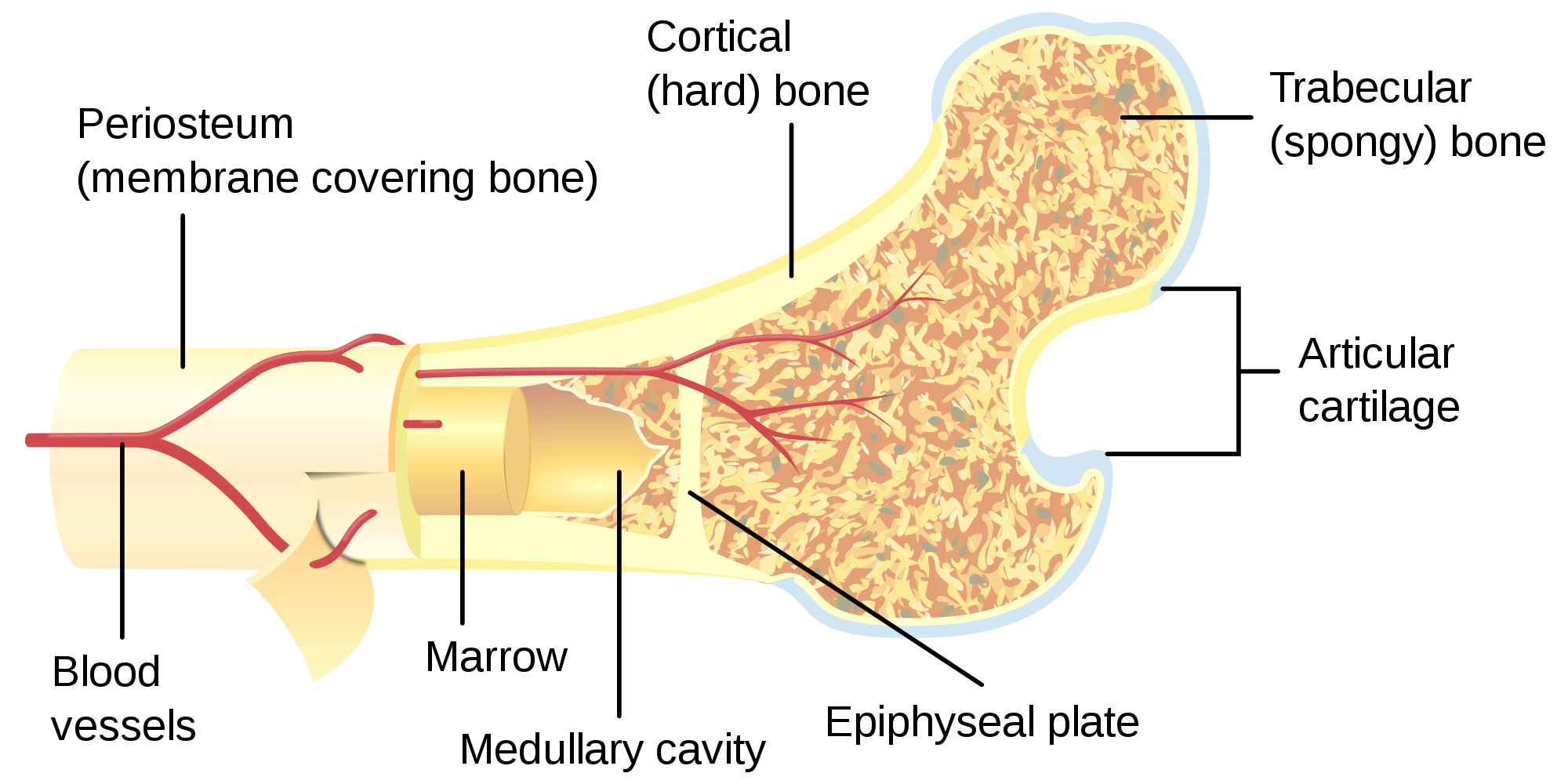 |
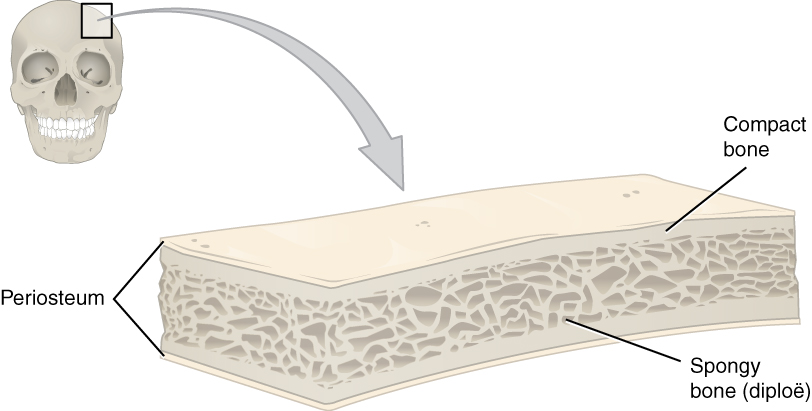 |
Compact bone tissue forms the extremely hard outside layer of bones. Compact bone tissue gives bone its smooth, dense, solid appearance. It accounts for about 80% of the total bone mass of the adult skeleton. Spongy bone tissue fills part or all of the interior of many bones. As its name suggests, spongy bone is porous like a sponge, containing an irregular network of spaces, as shown in Figures 11.4.4 and 11.4.5. This makes spongy bone much less dense than compact bone. Spongy bone has a greater surface area than compact bone, but makes up only 20% of bone mass.
 |
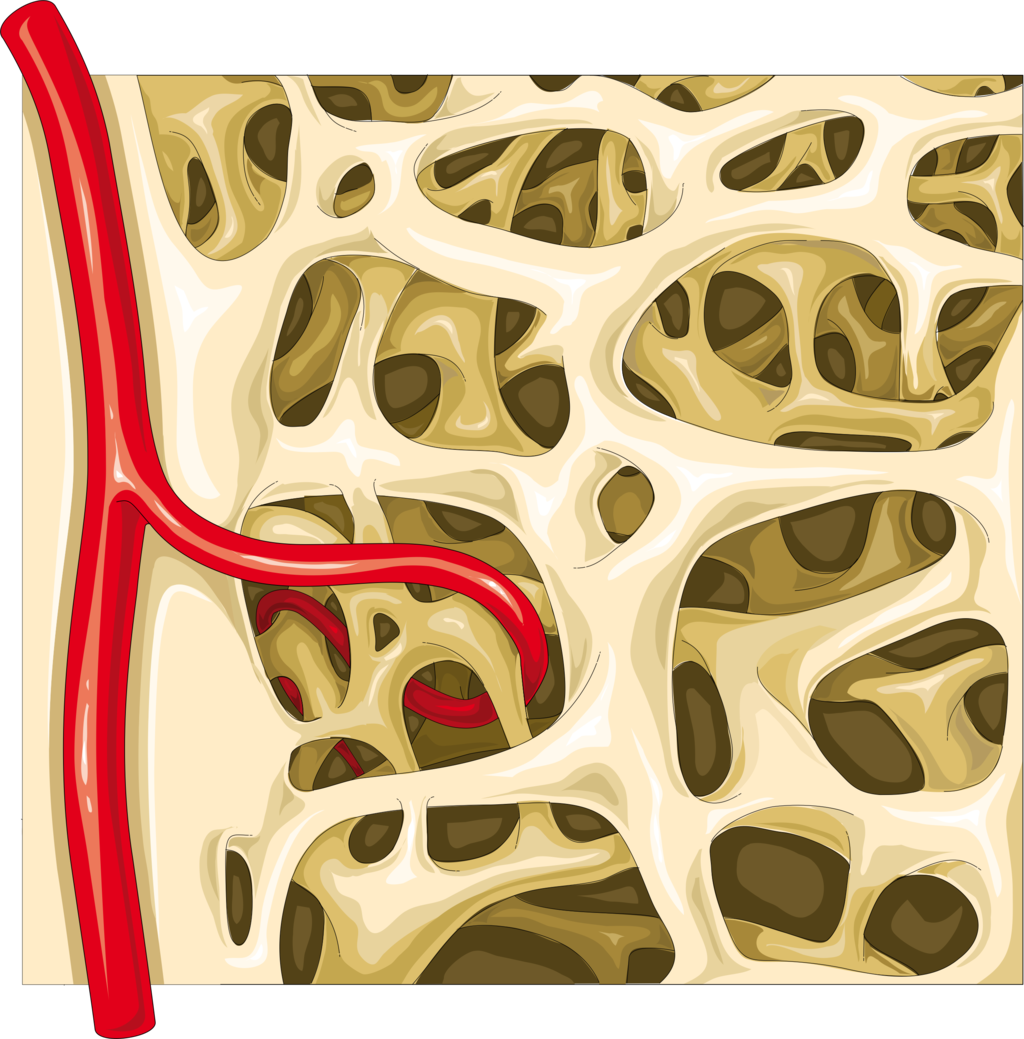 |
Both compact and spongy bone tissues have the same types of cells, but they differ in how the cells are arranged. The cells in compact bone are arranged in multiple microscopic columns, whereas the cells in spongy bone are arranged in a looser, more open network. These cellular differences explain why compact and spongy bone tissues have such different structures.
Other Tissues in Bones
Besides compact and spongy bone tissues, bones contain several other tissues, including blood vessels and nerves. In addition, bones contain bone marrow and periosteum.
- Bone marrow is a soft connective tissue found inside a cavity, called the marrow cavity. There are two types of marrow in adults — yellow bone marrow (which consists mostly of fat) and red bone marrow. All marrow is red in newborns, but by adulthood, much of the red marrow has changed to yellow marrow. In adults, red marrow is found mainly in the femur, ribs, vertebrae, and pelvic bones. Only red bone marrow contains hematopoietic stem cells that give rise to red blood cells, white blood cells, and platelets in the process of hematopoiesis.
- Periosteum is a tough, fibrous membrane that covers the outer surface of bones. It provides a protective covering for compact bone tissue. It is also the source of new bone cells.
Bone Cells
As shown in Figure 11.4.6, bone tissues are composed of four different types of bone cells: osteoblasts, osteocytes, osteoclasts, and osteogenic cells.
- Osteoblasts are bone cells with a single nucleus that make and mineralize bone matrix. They make a protein mixture that is composed primarily of collagen and creates the organic part of the matrix. They also release calcium and phosphate ions that form mineral crystals within the matrix. In addition, they produce hormones that play a role in the mineralization of the matrix.
- Osteocytes are mainly inactive bone cells that form from osteoblasts that have become entrapped within their own bone matrix. Osteocytes help regulate the formation and breakdown of bone tissue. They have multiple cell projections that are thought to be involved in communication with other bone cells.
- Osteoclasts are bone cells with multiple nuclei that resorb bone tissue and break down bone. They dissolve the minerals in bone and release them into the blood.
- Osteogenic cells are undifferentiated stem cells. They are the only bone cells that can divide. When they do, they differentiate and develop into osteoblasts.
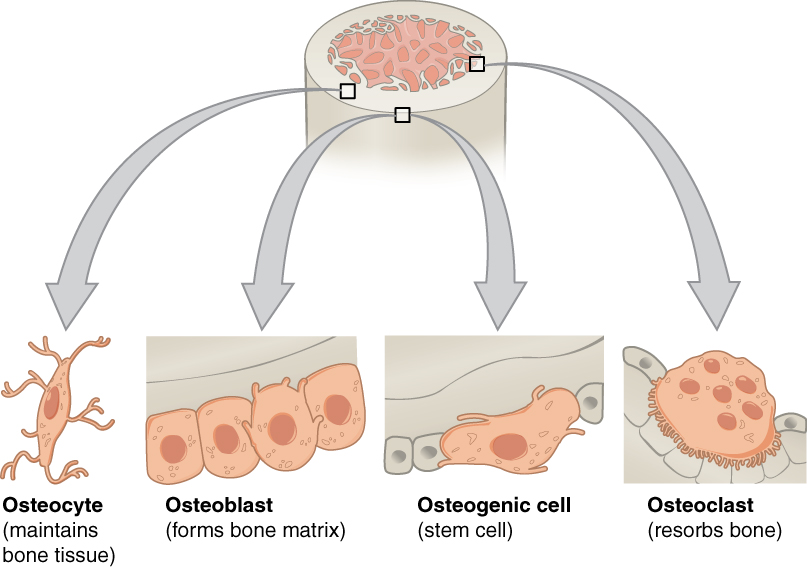
Bone is very active tissue. It is constantly remodeled by the work of osteoblasts and osteoclasts. Osteoblasts continuously make new bone, and osteoclasts keep breaking down bone. This allows for minor repair of bones, as well as homeostasis of mineral ions in the blood.
Types of Bones
There are six types of bones in the human body, categorized based on their shape or location: long, short, flat, sesamoid, sutural, and irregular bones. You can see an example of each type of bone in Figure 11.4.7.
- Long bones are characterized by a shaft that is much longer than it is wide, and by a rounded head at each end of the shaft. Long bones are made mostly of compact bone, with lesser amounts of spongy bone and marrow. Most bones of the limbs, including those of the fingers and toes, are long bones.
- Short bones are roughly cube-shaped and have only a thin layer of compact bone surrounding a spongy bone interior. The bones of the wrists and ankles are short bones.
- Flat bones are thin and generally curved, with two parallel layers of compact bone sandwiching a layer of spongy bone. Most of the bones of the skull are flat bones, as is the sternum (breast bone).
- Sesamoid bones are embedded in tendons, the connective tissues that bind muscles to bones. Sesamoid bones hold tendons farther away from joints, so the angle of the tendons is increased, thus increasing the leverage of muscles. The patella (knee cap) is an example of a sesamoid bone.
- Sutural bones are very small bones located between the major bones of the skull, within the joints (sutures) between the larger bones. They are not always present.
- Irregular bones are those that do not fit into any of the above categories. They generally consist of thin layers of compact bone surrounding a spongy bone interior. Their shapes are irregular and complicated. Examples of irregular bones include the vertebrae and the bones of the pelvis.

Feature: Reliable Sources
Diseased or damaged bone marrow can be replaced by donated bone marrow cells, which help treat and often cure many life-threatening conditions, including leukemia, lymphoma, sickle cell anemia, and thalassemia. If a bone marrow transplant is successful, the new bone marrow will start making healthy blood cells and improve the patient’s condition.
Learn more about bone marrow donation, and consider whether you might want to do it yourself. Find reliable sources to answer the following questions:
- How does one become a potential bone marrow donor?
- Who can and who cannot donate bone marrow?
- How is a bone marrow donation made?
- What risks are there in donating bone marrow?
11.4 Summary
- Bones are organs that consist mainly of bone tissue (or osseous tissue). Osseous tissue is a type of connective tissue consisting of a collagen matrix that is mineralized with calcium and phosphorus crystals. The combination of flexible collagen and minerals makes bone hard, without making it brittle.
- There are two types of osseous tissues: compact bone tissue and spongy bone tissue. Compact bone tissue is smooth and dense. It forms the outer layer of bones. Spongy bone tissue is porous and light, and it is found inside many bones.
- Besides osseous tissues, bones also contain nerves, blood vessels, bone marrow, and periosteum.
- Bone tissue is composed of four different types of bone cells: osteoblasts, osteocytes, osteoclasts, and osteogenic cells. Osteoblasts form new collagen matrix and mineralize it, osteoclasts break down bone, osteocytes regulate the formation and breakdown of bone, and osteogenic cells divide and differentiate to form new osteoblasts. Bone is a very active tissue, constantly being remodeled by the work of osteoblasts and osteoclasts.
- There are six types of bones in the human body: long bones (such as the limb bones), short bones (such as the wrist bones), sesamoid bones (such as the patella), sutural bones in the skull, and irregular bones (such as the vertebrae).
11.4 Review Questions
- Describe osseous tissue.
- Why are bones hard, but not brittle?
- Compare and contrast the compact and spongy bone.
- What non-osseous tissues are found in bones?
- List four types of bone cells and their functions.
- Identify six types of bones. Give an example of each type.
-
- Compare and contrast yellow bone marrow and red bone marrow.
- Which type of bone cell divides to produce new bone cells? Where is this cell type located?
- Where do osteoblasts and osteocytes come from? How are they related to each other?
- Which type of bone is embedded in tendons?
11.4 Explore More
The Skeletal System: Crash Course A&P #19, CrashCourse, 2015.
Bone Remodeling and Modeling, Amgen, 2012.
How bones make blood – Melody Smith, TED-Ed, 2020.
Attributions
Figure 11.4.1
Bone_marrow_grilled_on_the_barbecue,_sliced_young_raw_garlic,_salted_leek_flowers_from_last_year,_lovage,_and_kale_(19098148350) by City Foodsters on Wikimedia Commons is used under a CC BY 2.0 (https://creativecommons.org/licenses/by/2.0) license.
Figure 11.4.2
Bone_cross-section.svg by Pbroks13 on Wikimedia Commons is used under a CC BY 3.0 (https://creativecommons.org/licenses/by/3.0) license.
Figure 11.4.3
Anatomy_of_a_Flat_Bone by OpenStax College on Wikimedia Commons is used under a CC BY 3.0 (https://creativecommons.org/licenses/by/3.0) license.
Figure 11.4.4
the-detail-of-the-bones-the-structure-of-the-bones-spongy-bone-tramčina-close-up-structure on pxfuel are used according to the pxfuel Terms of Use.
Figure 11.4.5
Spongy_bone_-_Trabecular_bone_2_–_Smart-Servier by Laboratoires Servier/ Smart Servier website on Wikimedia Commons is used under a CC BY-SA 3.0 (https://creativecommons.org/licenses/by-sa/3.0) license.
Figure 11.4.6
Bone_cells by OpenStax College on Wikimedia Commons is used under a CC BY 3.0 (https://creativecommons.org/licenses/by/3.0) license.
Figure 11.4.7
Blausen_0229_ClassificationofBones by BruceBlaus on Wikimedia Commons is used under a CC BY 3.0 (https://creativecommons.org/licenses/by/3.0/deed.en) license.
References
Amgen. (2012, January 19). Bone remodeling and modeling. YouTube. https://www.youtube.com/watch?v=0dV1Bwe2v6c
Betts, J. G., Young, K.A., Wise, J.A., Johnson, E., Poe, B., Kruse, D.H., Korol, O., Johnson, J.E., Womble, M., DeSaix, P. (2013, June 19). Figure 6.9 Anatomy of a flat bone [digital image]. In Anatomy and Physiology (Section 6.3). OpenStax. https://openstax.org/books/anatomy-and-physiology/pages/6-3-bone-structure
Betts, J. G., Young, K.A., Wise, J.A., Johnson, E., Poe, B., Kruse, D.H., Korol, O., Johnson, J.E., Womble, M., DeSaix, P. (2013, June 19). Figure 6.11 Bone cells [digital image]. In Anatomy and Physiology (Section 6.3). OpenStax. https://openstax.org/books/anatomy-and-physiology/pages/6-3-bone-structure
CK-12 Foundation. (n.d.). Communication: Identifies means of communication between animals. ck12.org. https://www.ck12.org/c/life-science/communication/
CrashCourse. (2015, May 18). The skeletal system: Crash Course A&P #19. YouTube. https://www.youtube.com/watch?v=rDGqkMHPDqE
TED-Ed. (2020, January 27). How bones make blood – Melody Smith. YouTube. https://www.youtube.com/watch?v=1Qfmkd6C8u8
A soft connective tissue in spongy bone that produces blood cells.
A rigid organ that constitutes part of the vertebrate skeleton in animals.
The hard connective tissue in bones that consists mainly of mineralized collagen matrix; also called osseous tissue.
The main structural protein in the extracellular matrix in the various connective tissues in the body. As the main component of connective tissue, it is the most abundant protein in mammals, making up from 25% to 35% of the whole-body protein content.
A type of bone tissue that is smooth and dense and makes up the outer layer of bones.
A light-weight, porous inner layer of bone that contains bone marrow.
The process in which red blood cells, white blood cells, and platelets are produced by red bone marrow.
A tough, fibrous membrane that covers the outer surface of bones.
A type of bone cell that makes and mineralizes bone matrix.
A type of bone cell that helps regulate the formation and breakdown of bone tissue.
A type of bone cell that breaks down bone, dissolves its minerals, and releases them into the blood.
A type of stem cell that can divide and differentiate to form new bone cells.
The ability of an organism to maintain constant internal conditions despite external changes.
A hard, dense bone that provide strength, structure, and mobility. The thigh bone (femur) is an example of a long bone. A long bone has a shaft and two ends.
Bones that are as wide as they are long. Their primary function is to provide support and stability with little to no movement.
Bones made up of a layer of spongy bone between two thin layers of compact bone. They have a flat shape, not rounded. Examples include the skull and rib bones. Flat bones have marrow, but they do not have a bone marrow cavity.
A small independent bone or bony nodule developed in a tendon where it passes over an angular structure, typically in the hands and feet. The kneecap is a particularly large sesamoid bone.
Accessory bones which occur within the skull. They get a different name, derivative from the suture or sutures they are in contact with or with the center of ossification or fontanel where they originate.
Bones which vary in shape and structure and therefore do not fit into any other category (flat, short, long, or sesamoid). They often have a fairly complex shape, which helps protect internal organs. For example, the vertebrae, irregular bones of the vertebral column, protect the spinal cord.
A structure in the nervous system that consists of cable-like bundles of axons and makes up the majority of the peripheral nervous system.
A hollow, tube-like structure through which blood flows in the cardiovascular system; vein, artery, or capillary.

